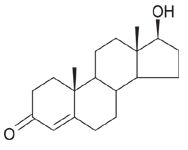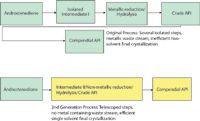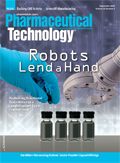A Green Manufacturing Route to Testosterone
A second-generation and green manufacturing process for testosterone provided economic and ecological benefits.
Pfizer Global Manufacturing (PGM) takes a proactive approach to minimizing the environmental impact of its worldwide network of manufacturing sites and facilities. At the site level, multidisciplinary teams apply green-chemistry principles to process development to enhance process robustness. Such an approach can reduce emissions, lower the use of hazardous materials, and enable more process waste to be recycled. Pfizer's improved testosterone process is an example of such an approach.
Pfizer's Kalamazoo, Michigan, manufacturing site has a long history of producing steroids, including testosterone (see Figure 1), for Pfizer's Established Products Business Unit and by Pfizer CentreSource for third-party sale. Used primarily in male-hormone replacement therapy, testosterone is the registered starting material for testosterone cypionate, the active pharmaceutical ingredient (API) in Pfizer's DePo testosterone product.

Figure 1: Molecular structure of testosterone. (FIGURES ARE COURTESY OF THE AUTHORS)
Pfizer improved its testosterone process by developing a green bioprocess route that reduced solvent use, produced less waste, and eliminated hazardous material use. The goal of the project was to develop an improved process for the testosterone synthesis that applied Pfizer's Right First Time philosophy (i.e., a scientific approach to continuous improvement to reduce the variation in processes and optimize them) as well as incorporate the principles of quality by design (QbD), green chemistry, lean manufacturing, and similar principles to reduce waste, minimize environmental impact, optimize efficiency and speed-to-market, ensure quality, and maximize operator safety.
The new manufacturing route to testosterone is shown in Figure 2. In the process, the starting material (i.e., androstenedione) is taken into solution and a proprietary intermediate is prepared, crystallized, and filtered. Then, rather than isolating a "dried cake," the intermediate is dissolved off of the filter and cycled back into the original vessel, ready for the next reaction. This scheme is repeated under the final crystallization, which is performed in a workcenter specifically for finishing APIs.

Figure 2: Second-generation or greener route to testosterone. (FIGURES ARE COURTESY OF THE AUTHORS)
In addition to requiring high volumes of solvent, the "old" testosterone process generated hazardous wastestreams that had to be dealt with during each manufacturing cycle. The process-development phase of the improved testosterone process leveraged existing infrastructure, economies of scale, process telescoping, and systematic application of QbD principles to overcome this and other challenges. More robust earlier process steps enabled the downstream purifications to use fewer solvents and relatively less solvent per kilogram to achieve quality equivalent to the previous process material. A big part of the green process was that it no longer generated a heavy-metals waste stream. These are problematic to dispose of, and eliminating them is a key benefit. The efficiency of the new chemistry allowed the solvent/product ratio to be reduced in later steps, which is a welcomed secondary benefit, and one not realized until the development of the new route.
Using a new intermediate and optimizing reagents were also successfully explored during the development process. The new intermediate enabled the use of a nonmetallic reducing agent, which significantly reduced hazardous waste and improved process safety. Operating a "cleaner" reaction improved efficiency by 50% in the final recrystallization in regard with solvent usage. These results combined to reduce overall hazardous waste streams and boost waste-stream recycling.
The development process demonstrated the viability of the improved testosterone process. A second-generation testosterone multidisciplinary implementation team, consisting of staff with expertise in bioprocessing, chemical synthesis, and engineering was formed to redefine the process agility and compile documentation for current good manufacturing practice documentation, including quality and safety. The next step was pilot-plant production of reduced-scale qualification lots. Full-scale implementation of the improved testosterone process was completed six months later. In all, the time for process development to laboratory scale to process validation for commercial manufacture was 13 months. The key benefits were as follows:
- Reduced raw material usage and trimmed manufacturing time to produce testosterone products of equivalent to historic Pfizer standards
- Reduced solvent use by 50%
- Eliminated use of several hazardous materials and improved process safety. The reagent, Neat-DIBAL, which is highly pyrophoric was eliminated. As this material has the potential for rapid reactivity with water or air, it must be handled with specialized storage and transfer equipment.
- Improved final recrystallization with regard to solvent usage
- Reduced hazardous waste streams
- Improved waste-stream recycling by 30%.
Other examples of green-chemistry at work
The improved route to testosterone is one example of Pfizer's application of green-chemistry principles. Some other examples are:
- Reduced 65% of the total organic waste (3.5 million liters per year of methanol and tetrahydrofuran) and eliminated liquid nitrogen in one step in manufacturing atorvastatin, the API in Pfizer's Lipitor.
- Avoided 5 million gallons of solvent per year and more than 150 tons of the nickel catalyst using a third-generation synthesis in the manufacture of pregabalin, the API in Lyrica.
- Eliminated 25,000 tons of waste per year in the manufacture of voricanazole, the API in Vfend through a green-chemistry modification in the manufacturing process. The synthesis utilizes two highly innovative types of chemistry: an ultra-efficient synthesis of the key pyrimidinone intermediate and the development of a novel highly diastereoselective Reformatksy coupling reaction.
These examples show the technical and economic benefits of applying green-chemistry in API manufacturing.
Bill Kovats is director and team leader of continuous improvement at Pfizer Global Manufacturing in Kalamazoo, Michigan. Kenneth Ball* is marketing manager of fine chemicals at Pfizer CentreSource, tel. 269.833.4436, kenneth.f.ball@pfizer.com
*To whom all correspondence should be addressed.
For more on this topic, see "Green API Manufacturing."

Telix Enters Agreement with ImaginAb to Purchase Next-Gen Therapeutic Candidates
Published: January 13th 2025 | Updated: January 13th 2025The transaction adds a pipeline of early-stage drug candidates against high-value targets to Telix’s portfolio, along with other novel targets currently in the discovery stage.
Drug Solutions Podcast: Gliding Through the Ins and Outs of the Pharma Supply Chain
November 14th 2023In this episode of the Drug Solutions podcast, Jill Murphy, former editor, speaks with Bourji Mourad, partnership director at ThermoSafe, about the supply chain in the pharmaceutical industry, specifically related to packaging, pharma air freight, and the pressure on suppliers with post-COVID-19 changes on delivery.